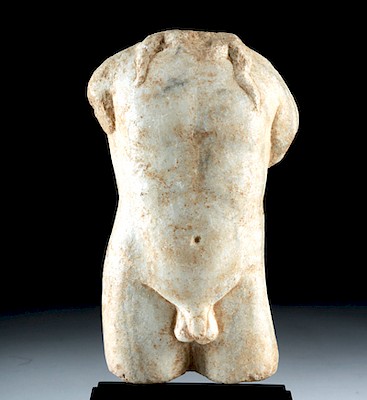Romano-Egyptian Terracotta Head of Serapis
Lot 10a
About Seller
Artemis Fine Arts
686 S Taylor Ave, Ste 106
Louisville, CO 80027
United States
Selling antiquities, ancient and ethnographic art online since 1993, Artemis Gallery specializes in Classical Antiquities (Egyptian, Greek, Roman, Near Eastern), Asian, Pre-Columbian, African / Tribal / Oceanographic art. Our extensive inventory includes pottery, stone, metal, wood, glass and textil...Read more
Estimate:
$400 - $600
Absentee vs Live bid
Two ways to bid:
- Leave a max absentee bid and the platform will bid on your behalf up to your maximum bid during the live auction.
- Bid live during the auction and your bids will be submitted real-time to the auctioneer.
Bid Increments
| Price | Bid Increment |
|---|---|
| $0 | $25 |
| $300 | $50 |
| $1,000 | $100 |
| $2,000 | $250 |
| $5,000 | $500 |
| $10,000 | $1,000 |
| $20,000 | $2,500 |
| $50,000 | $5,000 |
| $100,000 | $10,000 |
| $200,000 | $20,000 |
About Auction
By Artemis Fine Arts
Dec 5, 2018
Set Reminder
2018-12-05 10:00:00
2018-12-05 10:00:00
America/New_York
Bidsquare
Bidsquare : DAY 1 | Classical Antiquities & Asian Art
https://www.bidsquare.com/auctions/artemis-gallery/day-1-classical-antiquities-asian-art-3698
Day 1 of an important 2-day auction featuring ancient and ethnographic art from around the world. Egyptian, Greek, Roman, Viking, Near Eastern plus Asian Art from China, Japan, Thailand, Vietnam, Burma, India, more. Artemis Fine Arts info@artemisfinearts.com
Day 1 of an important 2-day auction featuring ancient and ethnographic art from around the world. Egyptian, Greek, Roman, Viking, Near Eastern plus Asian Art from China, Japan, Thailand, Vietnam, Burma, India, more. Artemis Fine Arts info@artemisfinearts.com
- Lot Description
Egypt, Romano-Egyptian Period, ca. 30 BCE to 2nd century CE. A hollow-molded terracotta head depicting the god Serapis, the Graeco-Egyptian god representative of the two deities Osiris and Apis who first appeared around the time of Alexander the Great. The deity is depicted with deep-set eyes beneath bushy brows, a closed mouth with accompanying moustache, wavy locks of cascading curly hair framing his visage, and a tall modius (kalathos) set atop his head. Ancient Romans did not typically respect the deities and belief systems of other ancient cultures; however, those in the Greek and Egyptian pantheons were revered. The god Serapis was originally created by Ptolemy I of Egypt as a means of unifying the Grecian and Egyptian cultures around the 3rd century BCE, though Romans were quick to adopt the cult of Serapis in favor of other overarching deities. Custom wooden display stand included. Size: 2" W x 3.375" H (5.1 cm x 8.6 cm); 5.7" H (14.5 cm) on included custom stand.
Provenance: private Lexington, Kentucky, USA collection; ex-private Texas, USA collection
All items legal to buy/sell under U.S. Statute covering cultural patrimony Code 2600, CHAPTER 14, and are guaranteed to be as described or your money back.
A Certificate of Authenticity will accompany all winning bids.
We ship worldwide and handle all shipping in-house for your convenience.
#139712Head was originally part of a larger item. Minor nicks and abrasions to face, modius, peripheries, and neck line, with softening to some finer details, and light encrustations. Light earthen deposits throughout.Condition
- Shipping Info
-
All shipping is handled in-house for your convenience. Your invoice from Artemis Gallery will include shipping calculation instructions. If in doubt, please inquire BEFORE bidding for estimated shipping costs for individual items.
-
- Buyer's Premium



 EUR
EUR CAD
CAD AUD
AUD GBP
GBP MXN
MXN HKD
HKD CNY
CNY MYR
MYR SEK
SEK SGD
SGD CHF
CHF THB
THB














